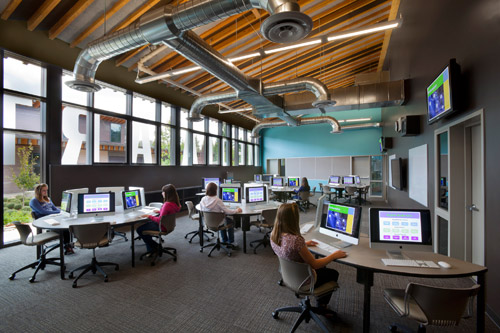Can Career Tech Education Facilities Really Turn Communities Around?
By Guest Blogger Steve Newsom
If you like happy endings, you’re going to enjoy the story of South Tahoe High School. Nestled in the High Sierra Mountains, among majestic peaks, world-class ski resorts, and giant sequoias, is a school that means business about preparing its students for the future. The strategy is to give these students career training, experience, and opportunities in high tech, curriculum-driven school facilities, in the spirit that they will have what they need to stay in the community and thrive.
 Educational leaders at South Tahoe High School and the Lake Tahoe Unified School District got together, and thought seriously about what kinds of programs they’d need to offer to prepare and meet the needs of their students, while also standing apart, in the competitive process to receive Career Technical Education (CTE) funds from the State of California. Their thoughtfulness and creativity paid off.
Educational leaders at South Tahoe High School and the Lake Tahoe Unified School District got together, and thought seriously about what kinds of programs they’d need to offer to prepare and meet the needs of their students, while also standing apart, in the competitive process to receive Career Technical Education (CTE) funds from the State of California. Their thoughtfulness and creativity paid off.
2007: They work with LPA to put together a District Facilities Master Plan.
2008: A voter-approved $64.5 million facilities bond is passed (known as Measure G), to fund new CTE facilities—together with grants and other financial aid.
2009: Construction begins on phases one and two of the five-part construction process to build 1) the $12.5 million CTE “Green” Construction and Transportation Academy and 2) the $12 million Stadium View Classroom Building—funded by an Overcrowding Relief Grant (ORG).
2010: Both the “Green” Construction and Transportation Academy and Stadium View Classroom Building are completed; while work begins on the $9.3 million Tahoe Arts and Design Academy (TADA).
2011: The TADA building is completed, and opens its doors to students; while work begins on a new Campus Commons Student Union—so that students will finally have a place to gather, eat, socialize, study, and more.
 The “Green” Construction and Transportation Academy is honored for its architectural merit by California’s Coalition for Adequate School Housing (CASH)—which recognizes design solutions that creatively meet educational program needs, the American Institute of Architects, and the Concrete Masonry Association of California and Nevada. It also makes the cover of School Planning and Management’s Annual Green Issue.
The “Green” Construction and Transportation Academy is honored for its architectural merit by California’s Coalition for Adequate School Housing (CASH)—which recognizes design solutions that creatively meet educational program needs, the American Institute of Architects, and the Concrete Masonry Association of California and Nevada. It also makes the cover of School Planning and Management’s Annual Green Issue.
2012: Construction on the Campus Commons Student Union will be completed, while work begins on the final phase of the campus transformation, the Sports Medicine Academy—expected to wrap construction in 2013.
We can only imagine what awards, national and peer recognition these standout career tech educational facilities will achieve in the coming years. Few other k-12 schools—if any in the nation—can rival what this school offers its students.
“The whole idea is that students will be ready for a job when they graduate high school,” said South Tahoe High School Principal Ivone Larson, in a recent article.
The speed with which these facilities have been dreamt up, approved, funded, designed, and constructed is enough to blow anyone’s socks off. It should also be very encouraging, especially if you’re a parent, educator, or simply have an interest in grooming the next generation for success. These digital natives are thriving in K-12 facilities that offer hands-on equipment, interactive environments, connections with nature (i.e. through daylight or natural ventilation), and integrated curriculum that inspires their teachers; all of which help them get passionate about what lies ahead. You can find all this and more at South Tahoe High School, and I look forward to keeping you up-to-date on other exciting happenings with this very special client.
Steve Newsom is a K-12 Schools Project Director at California-based LPA Inc. He has worked on more than 30 schools, for more than a dozen school districts. He is a LEED Accredited Professional, member of the American Institute of Architects and Board Member and Chair of the Architect's Committee and High Performance Schools Committee for the Coalition for Adequate School Housing.